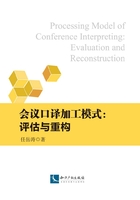
Foreword
Interpretation and translation is one of the most rapidly-developing professions today. The emergence of China as the world's second-largest economic power has increased the need for accurate communication, and interpretation and translation are at the very core of this process. The many conferences, both regional and international, held to facilitate formal and in-person communication has led to increased demand for high-quality conference interpreting.
Conference interpreting research(CIR)in the West has long been an independent discipline, with a history spanning more than six decades; in China, however, CIR has been conducted for no more than two. Major CIR findings are often represented in the form of a model that can be divided into different levels——anthropological, socio-professional, institutional, interactional, textual, cognitive and neural. The processing model sits at the cognitive level, which reflects the nature of interpreting. However, most processing models are based on interpreting between Western languages. With the rise of China, interpreting between Eastern and Western languages has come to the center of interpreting studies in recent years, which has left space for the further study of processing models for conference interpreting.
Interpretive Theory is one of the predominant theories in CIR. Seleskovitch, founder of the Paris School and Interpretive Theory(IT), notes that the Paris School views interpreting as a communicative activity that aims at conveying the sense thereof, while IT focuses on conference interpreting and sense. To do so, the interpreter has to explain the source language, which often involves cognitive supplement, a process of fusing the interpreter's language knowledge, subject knowledge, encyclopedic knowledge and contextual knowledge. The Effort Models and the XiaDa Model are representatives of the processing model. Both portray interpreting as“explaining”, that is, the interpreter interprets and conveys the sense of the communication, rather than the actual language. However, the two models were proposed nearly two decades ago, and can, to some degree, be refined to suit the changing demands of the developing market.